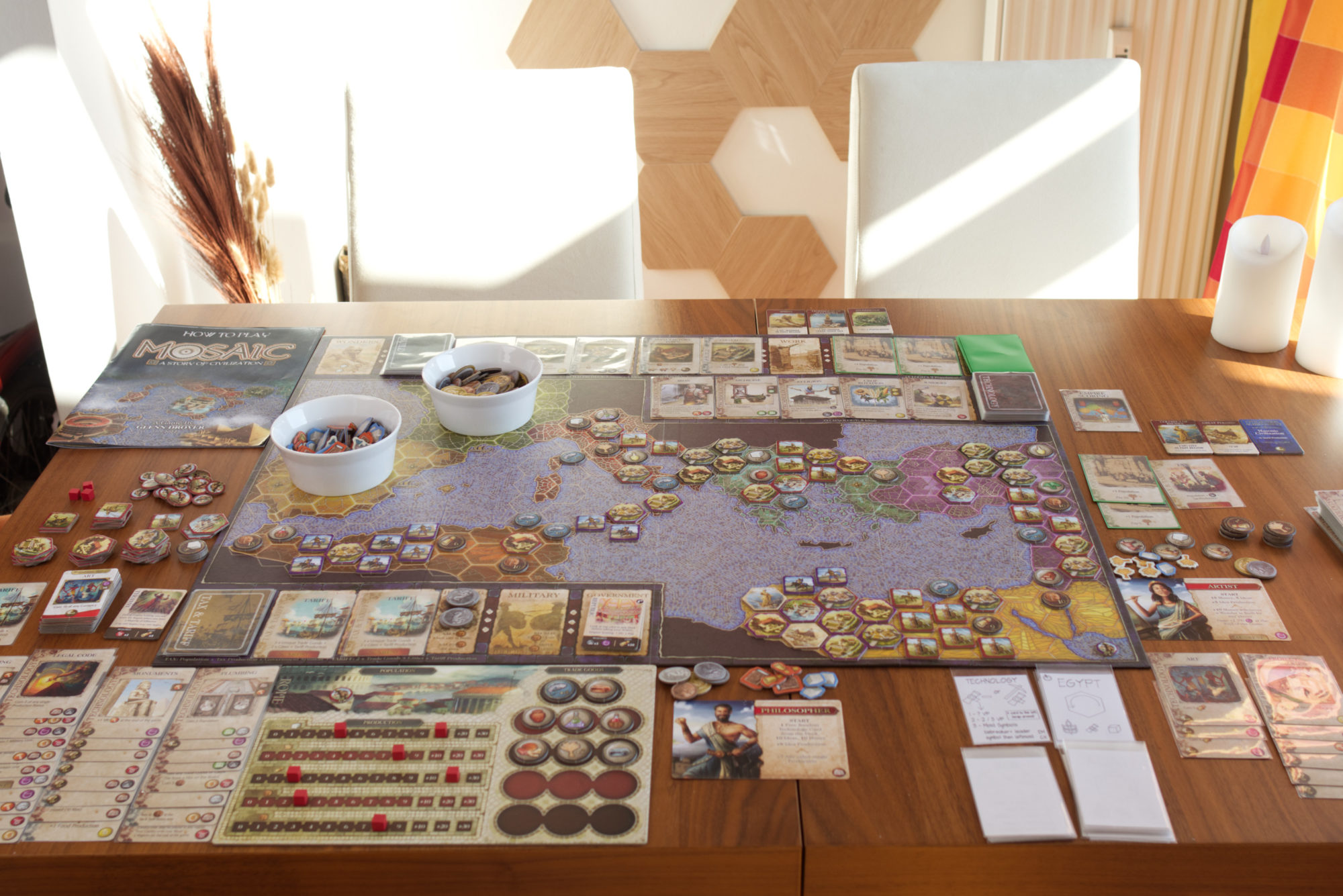Mosaic has been out for a while now, so in a sense I guess I’m kind of late to the party. This is another Kickstarter game where I held out on backing it, despite the gorgeous artwork, that enticing mosaic map and the allure of a civilisation game that wouldn’t take a whole day to play. I still remember how tempted I was and how often I switched between going all-in or not at all. Despite what my fondness for Foundations of Rome may suggest, I’m not a fan of having tons of miniatures or oversized game boxes. But that combination of civilisation style game, micro-turns that reminded me of Concordia, and that amazing presentation had me hooked.
So I’ve been eager for a chance to give this game a try, which wasn’t easy to come by, but I finally managed to get my hands on a copy of the retail edition. In the meantime, others have called it everything from utterly disappointing to game of the year, which got me even more curious. Here is what I found …
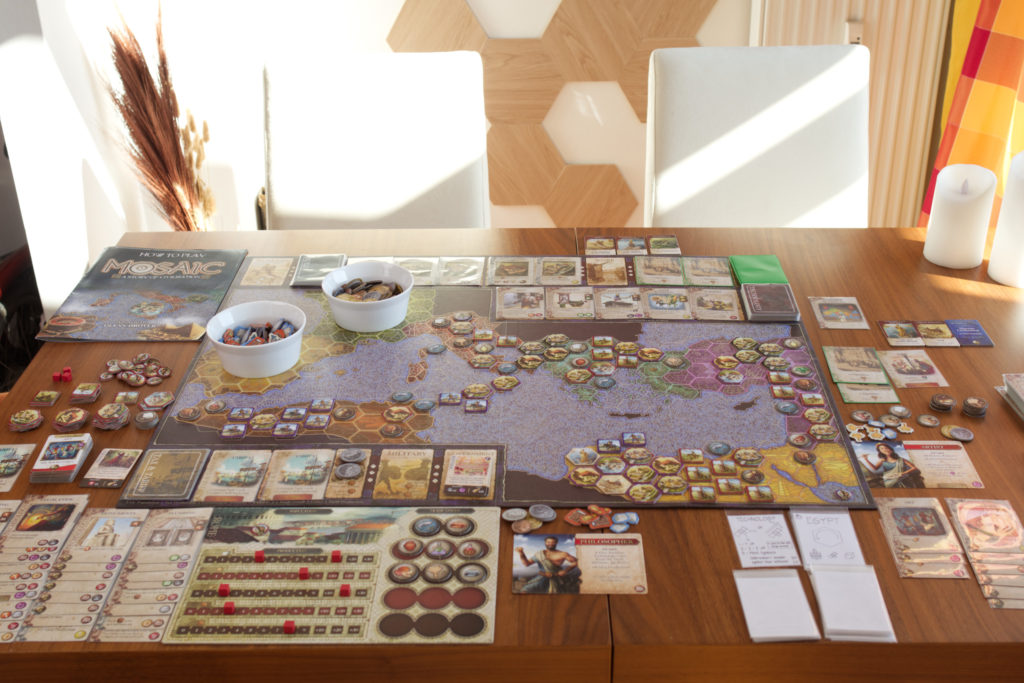
Setup
Even the retail edition without the miniatures or other extravagances of the Kickstarter editions is already a hefty experience. Taking the box out of the shipping package reminded me of my first encounter with The Colonists: how can a box that size be so heavy only containing cards and cardboard? The answer in this case: by filling it to the brim, literally! If you manage to get the lid closed and shake the box, there is hardly any noise because things are packed so tightly. Granted, my copy has all cards sleeved, that add’s a bit, still…
One contributing factor is that Mosaic can be played from 1 to an astonishing 6 players, each with their own set of coloured tokens, and an usual large number of cards. But the centre piece is of course that beautiful map of the Mediterranean.
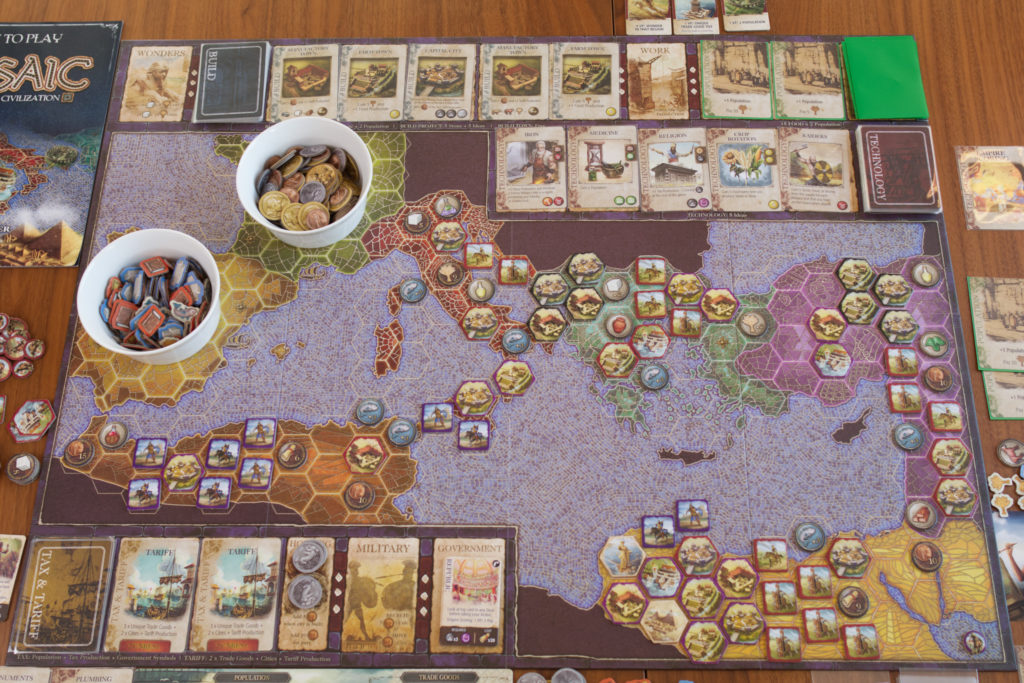
Setup time is quite substantial, especially since each hex on the board has to be seeded with a random marker representing a trade good (grey), a cache of resources (brown) or fishing (blue). A large part of the trade good tokens show an X and those are removed from the board so the remaining tokens form some irregular clusters. Once that part is done, there are decks for Tax & Tarif, Build, Technology, and Population that need to be prepared with their size changing depending on player count and a scoring card having to be shuffled in. The Technology deck is a bit annoying here because first a large number of starting technology cards have to be separated from which players draft 5 cards each, then be re-integrated and well shuffled before inserting the scoring card. There are also wonders, civilisation achievements, golden age tiles, each of which only a subset is randomly selected to be used for each session.
Another thing that gets drafted are the leaders each player will play, representing asymmetric starting resources, initial production capacities, as well unique ongoing effects. The impact of the chosen role is quite substantial with the builder being incentivised to focus on constructing cities and less on research for example.
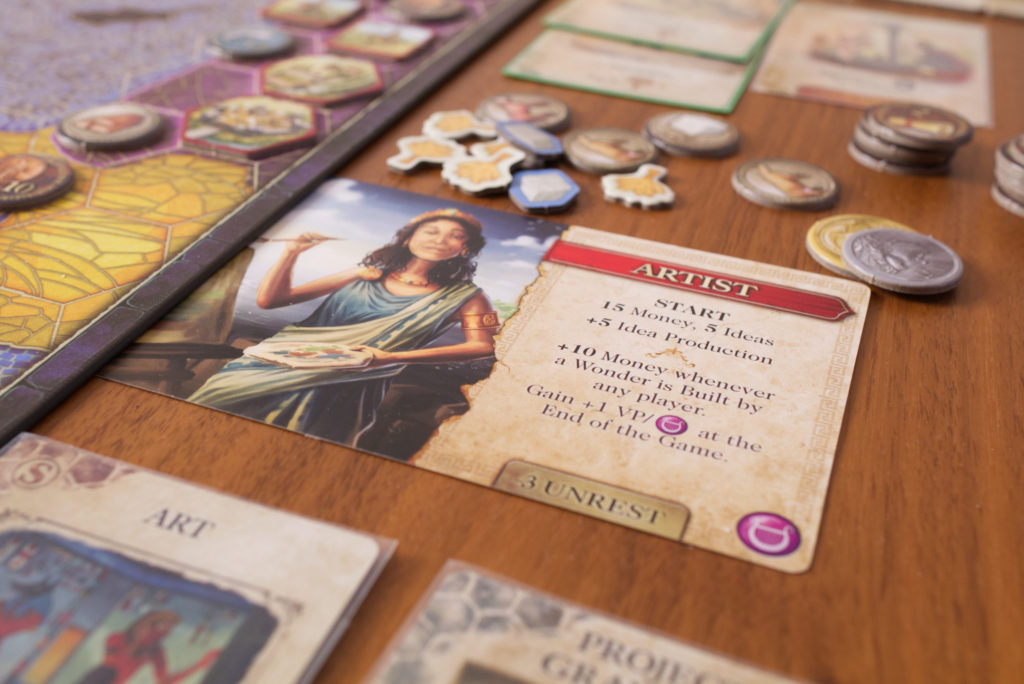
As for player components, each player gets a player board, some wooden cubes to mark their resource production on that board, as well as an assortment of military units, cities, towns, and population markers. Each player has the exact same set, just in their colour. It is a bit overwhelming to be handed so many pieces (the image below shows a mid game state where I had already build a lot), but luckily Mosaic is way less complicated to play than it might initially seem.
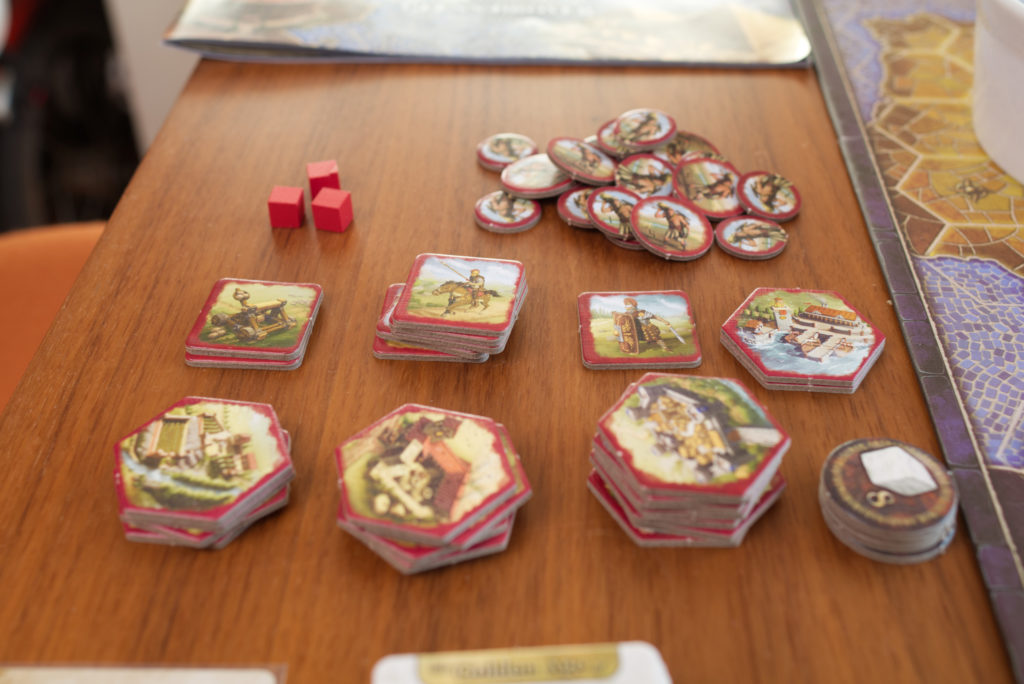
As a final part of setup, each player places one starting city on the board and if the hex contains a token, removes it and collects its reward. You can build anywhere you want. There are no adjacency rules, minimum distances or other restrictions so familiar from similar games. The only exception is that your initial city must be a regular, non-port city and only port cities can be placed on locations with a fish token on them. That’s it, pretty simple, right?
The Turn
On each turn, you are faced with a challenge: which one of 8 different actions do you want to perform this turn. This again sounds like potential overload but turns out not so. Despite the grandiose map and extensive setup, its civilisation theming and epic appearance, Mosaic is basically an efficiency race performed in micro-turns. Let’s take for example the first type of action: work. Pick one of the three currency types (ideas, food, stone), check on your player board what your current production level is and add the number of population markers you have on your player board. Gather that many resources, done, next player. The biggest hurdle here is that the 5er tokens for food and ideas look completely different than the 1er tokens.
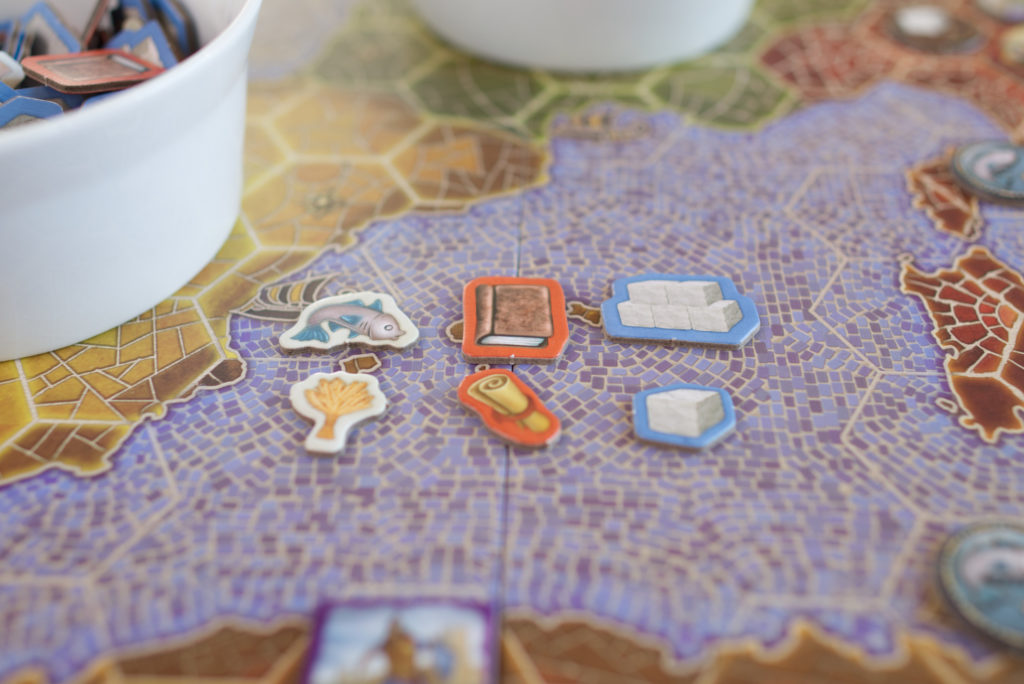
Most of the other actions are similarly simple: Population lets you exchange food for population, Tax & Tarif collect money (a universal currency that can be exchanged for the other resources) but also receive unrest (negative VP at end of game), Government lets you spent large amounts of ideas to acquire a unique bonus during empire scoring (more on that later), Wonder exchange increasing amounts of stone and food for erecting special buildings. There are of course details here, but I’m not glossing over too much. There are three actions that have more far reaching impact and therefore deserve a closer look:
First, let’s talk about Build. This encompasses actually three different things you might want to spend your stones, population and ideas on. We already know about building cities. The counter-intuitive part is that a city neither increases your production nor your population. In fact, it reduces your population by two besides costing five stone. Think of cities as rather military bases of operations. Yes, they allow you to pick up one of those initially seeded bonus tokens (trade good, cache, fish), but their main effect for the rest of the game is that you have 2 more points of influence in whatever region you place them. It doesn’t matter where you place them, what you place them next to. It’s +2 influence for you and that’s mostly it. So what does influence buy you? Remember those scoring cards that are inserted in each of the decks? When one is revealed, players check who has the most influence in each region and those players get VP. More on that later.
The other two implications of a city are that a) you can only recruit military units in regions where you have at least one city and b) that towns can only be placed directly next to cities. So what are towns you ask? Towns are free to build, they just cost you an action, and provide +1 influence for you (and of course allow you to snatch up more tokens from the board). What makes them attractive is that both cities and towns can come with additional advantages. In the top left of the board, there is a row of five Build cards. Whenever you build a city or town, you can pick up a matching card from this row, giving you additional bonuses. Note though that you don’t have to pick up a card. You can build for example a city if no city card is in the market, you’ll just not get any bonus.
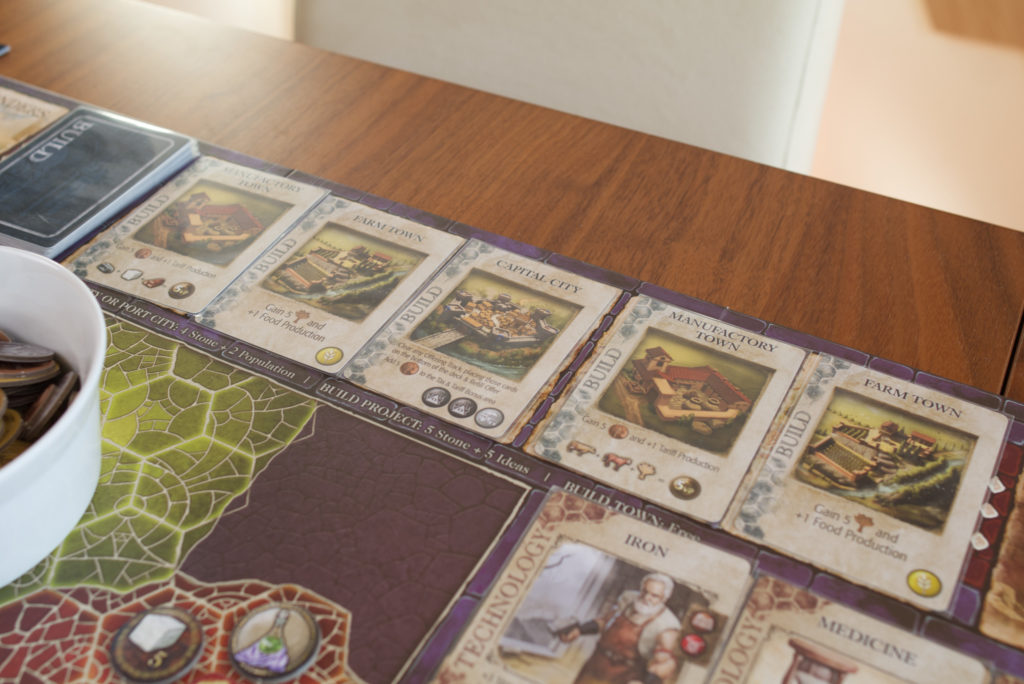
The final type of sub-action you can do for Build is to pick up a project card. These are quite pricy with 5 stone and 5 ideas, especially in the early game, but give you VP depending on symbols you will have noticed in the bottom right corner of the cards. These represent what the rule book calls “The Nine Pillars of Civilization”, things like culture, government, or food production. Which leads nicely into the next major action: Technology.
Technology
Mosaic comes with a huge deck of unique technology cards, although technology is a bit of a misnomer here. For one, the deck includes things such as religion which most people wouldn’t strictly consider a “technology”. For the other, most of the cards have a one-time instead of an ongoing power. The technology action is again very simple: pay five ideas, pick a card from the technology row, refill the row. If you fulfil the requirements of the card (printed as further symbols on the top right), you can immediately play it or wait for a later, more opportune moment. All technology cards also come with a set of symbols in the bottom right they in turn provide you (e.g. Religion provides one government and one culture symbol).
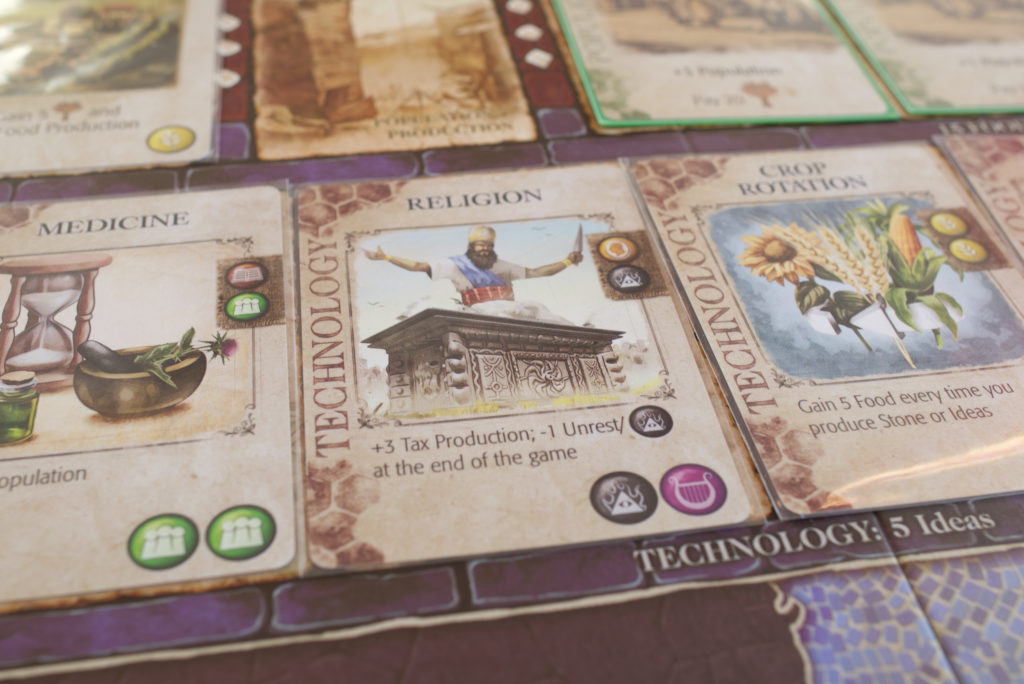
Mosaic’s technology cards are all over the place: some just give you things like 2 population, some give you resources depending on the number of certain symbols or towns you already own. Others provide endgame VP, yet others gift you military units and let you immediately eliminate another player’s unit as part of the card effect. Most of them you can forget about once they were bought and they only stay relevant for the symbols they provide. A few enable almost game breaking things like being completely protected from losing military units or gaining money whenever another player does something. It’s an odd mix to say the least.
To put things into perspective: you will buy a lot of technologies! And I mean A LOT a lot. Even if your leader doesn’t incentivise buying techs, you can easily end up with 30+ cards at the end of the game. It’s not even that you require basics techs to build more advance techs. It’s just that the tech action is relatively cheap and having more of the same kind of symbols can provide great bonuses. So if cities are less production centres and more military outputs, think of technology cards as more collectable one-time effects mixed with a few pretty good long lasting ones as well.
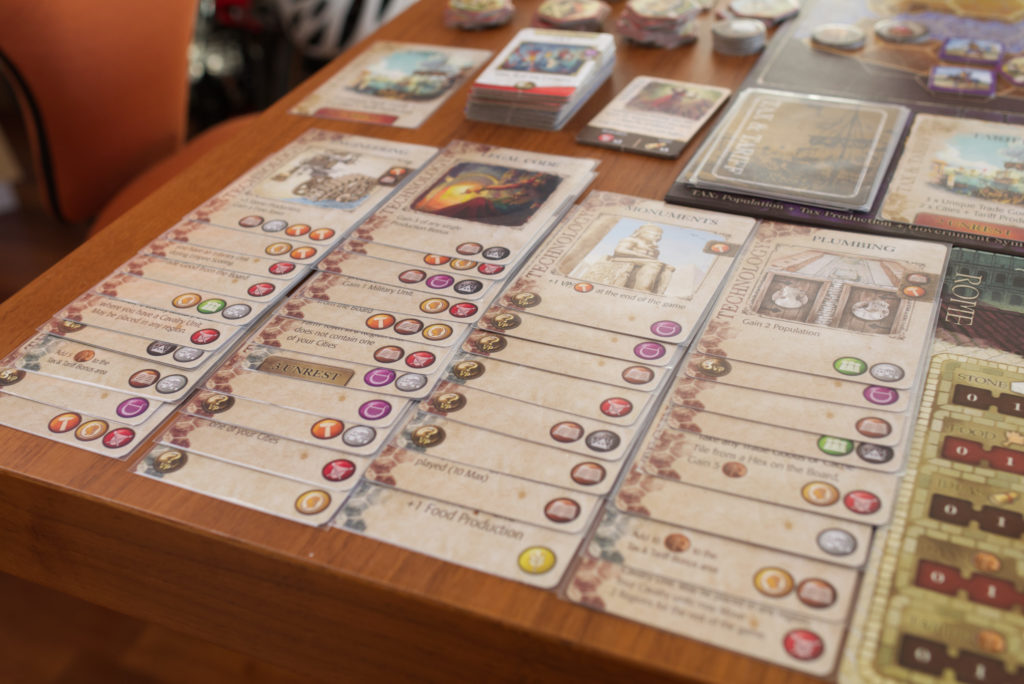
Military
Finally, there is military and true to the formula, the action is simple to comprehend … and again somewhat counter-intuitive. When performing this action, you can spend money to buy units and place them in regions where you have a city. You can also pay to move units to adjacent regions, shifting where they will spread their influence. For that is their primary purpose: each unit is worth +1 influence in the region it is in.
There is no attacking or defending, in fact it doesn’t matter where in the region they are placed and if someone wants to build on the hex where they stay, they are simply moved away. So if cities are military outposts, military units are mobile units of influence. While there are a few technology cards that allow you to remove an opponent’s unit once when they get bought, there is no active way to trigger an “attack”. Therefore military often becomes an arms race which can be countered by just putting down more and more cities in the same region. Compared to building a city, buying units is considerably cheaper though.
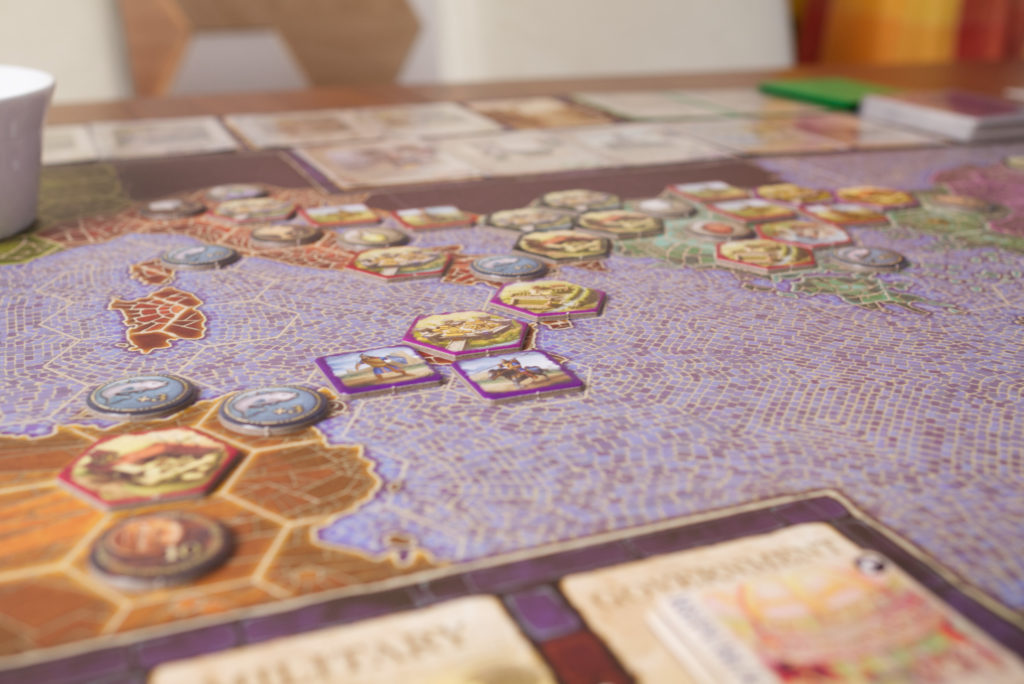
Empire Scoring
So let’s talk about what all that influence might get you. When one of the empire scoring cards is revealed, the game is interrupted for a scoring round. For each region, each player counts their influence (+2 per city/wonder, +1 per town and military unit) and whoever is second place gets 2VP. First place however gets 3VP + 1 per city/wonder. So naturally, players aim for taking control in a region another player is in as well rather than staying in region of their own.
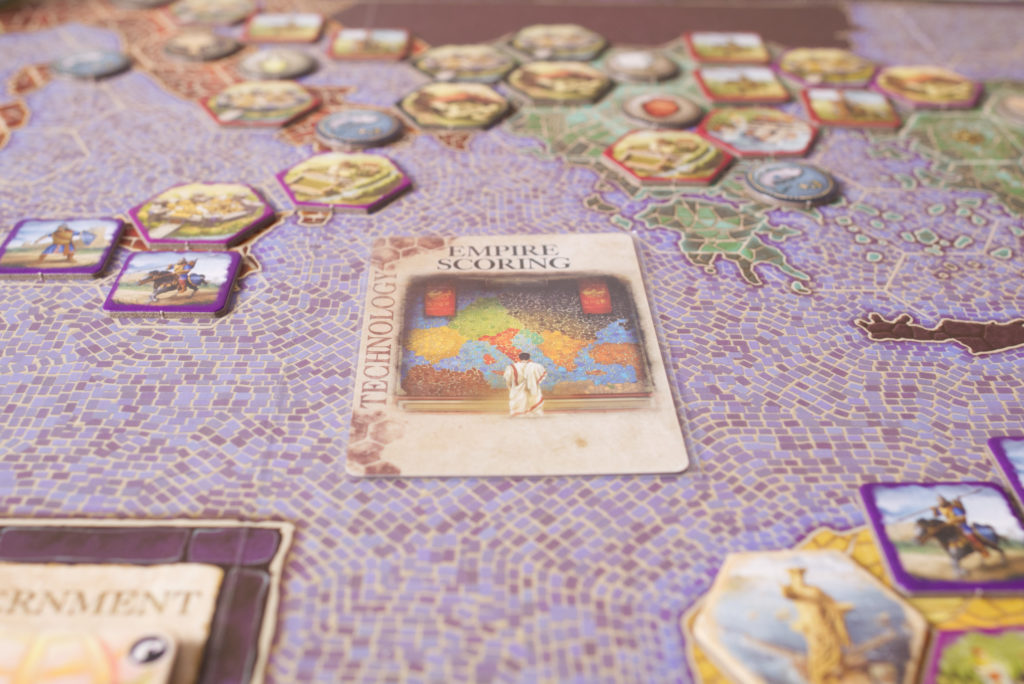
What makes scoring tricky is that both some colours are hard to separate (e.g. red vs purple) and that it’s not immediately apparent which tiles are cities and which are towns. To make it worse, when players build wonders, there is nothing on the board marking to which player they belong. So one has to go through each region and then check who has the matching larger wonder tile in front of them. While tricky during scoring, it makes evaluating the board state even more tricky during normal play where you can’t necessarily express your interest in knowing who’s player it is.
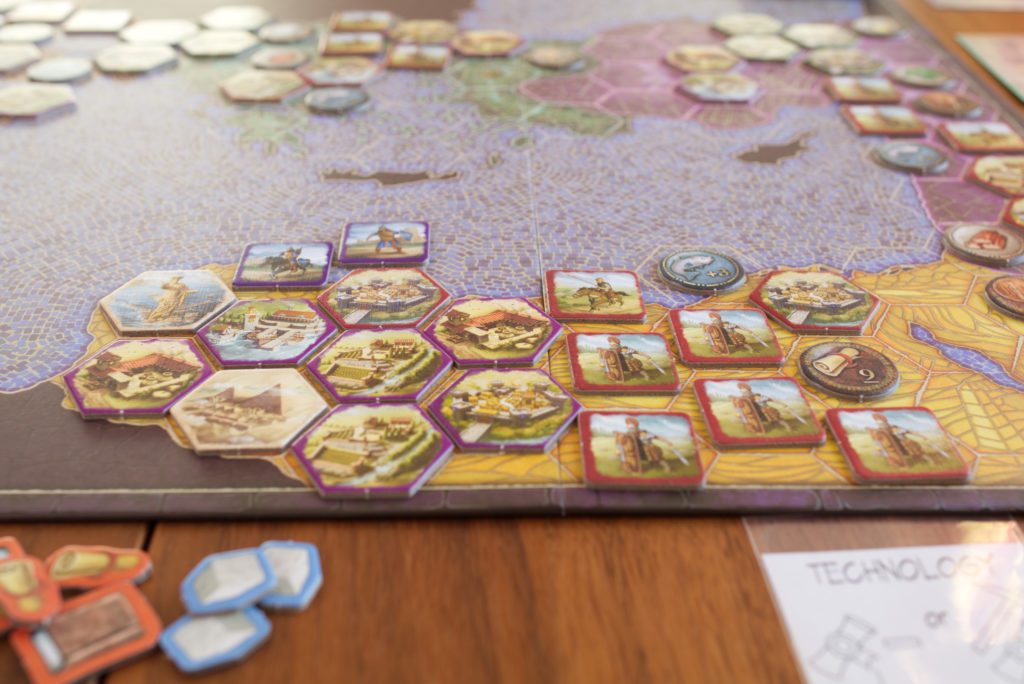
Game End
There are two ways the game can end: 1) once the third of fourth empire scoring cards is revealed or 2) if two out of the three shared “achievements” categories (civilisation achievements, golden ages, wonders) are depleted. I haven’t talked about those in-depth, so lets do so now.
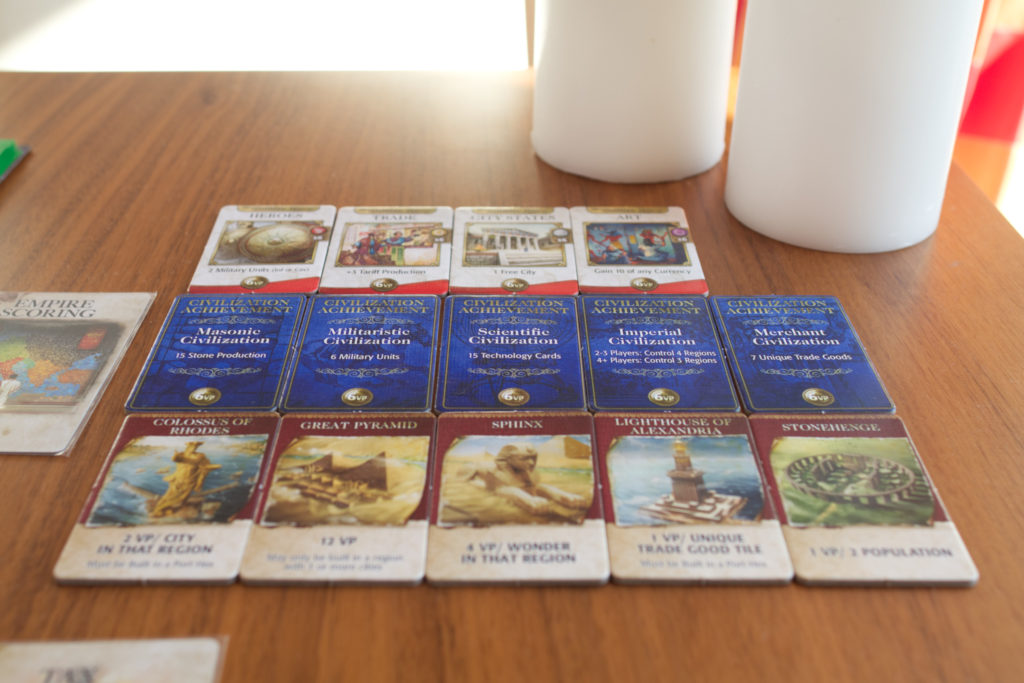
Civilization achievements are each worth 6VP for the first player to hit a certain condition such as having reached an idea production of at least 15 or controlling a certain amount of regions. Golden Age rewards are similar but require a player to have collected 6 of a certain symbol (e.g. the red military symbol found on various technology and build cards). Golden age rewards are also worth 6VP but come with an additional one-time bonus such as gaining 2 military units. Wonders can be built via the wonder action and just require a large amount of stone and food. They can provide large amounts of VP if placed in the right region.
All of these act as a shared incentive and players race to snatch up as many of those as they can. Their importance cannot be overemphasised. From the initial drafting of starting technologies and placing the initial starting city, players should zero in on a couple of those and try to reach them before someone else can beat them to it.
But those are only one part that contributes to the overall score. Besides the empire scoring values, the achievements, golden age, wonders, there are also manufacture towns that reward collecting certain trade good tokes, some techs that provide fixed VP and of course the technology and project cards that provide 1VP per a certain symbol you have collected. Let’s just say there are many sources of points.
Solo Mode
There exists an official solo mode for Mosaic, but it is not part of the retail edition. I guess it was removed as a cost cutting measure, but I was disappointed to learn about it. A BGG user has created an alternative set of cards matching the functionality of the official card set and the solo rules can be found as PDFs. That’s what I used to play Mosaic solo. While I can understand the cost aspect, having a PnP version for download or a simple online version would have been a most welcome touch.
If you are considering printing those cards, I would say don’t bother. While the automa has various levels of difficulty and “expansion styles” (aggressive, isolationist, …), in essence it is a constraint-randomness source of taking things away. There is no strategy to it and it doesn’t conform to some of the most essential rules of the game. For example, it can pick up any tech card regardless of whether it would fulfil the tech’s requirement or not. It also uses no intelligence when placing new cities/towns/units which can lead it to dump a lot of units into low-valued regions instead of putting them into hotly contested ones.
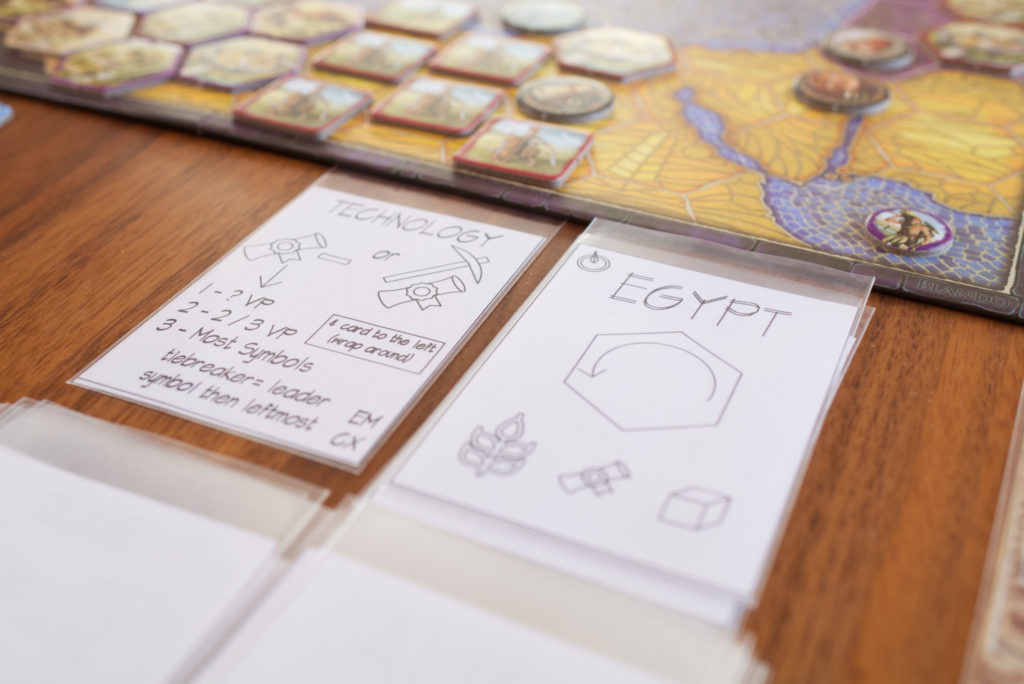
I tried the solo mode multiple times, with different “strategies” and difficulties. In two cases, I aborted the game because I got bored. In none of the games was the bot a challenge that had me adapt my play style or strategy. But most importantly, it fails to capture the race-like character of Mosaic. In a multiplayer game, I have to carefully consider when I buy what tech, whether I can do one more production round or have to snatch something up immediately, who is going for what achievements, and so on. All of this is lost in the solo mode. What happens is that the bot in a constraint-random nature places cities, towns and units on the board and thus fights for majorities (without doing so efficiently) and snatches up all project and VP-contributing tech cards it can. And due to the somewhat obtuse scoring at game’s end, it is difficult to judge how well the bot is doing during the game. In a multiplayer game, one can easily see for example for which symbol someone is going for and try to cut them off.
If you like more multiplayer-solitaire-style experiences, this bot might work for you. Personally, I found it failed to capture the most fun aspect of Mosaic for me.
Retail vs Kickstarter
I hadn’t had a chance to handle either of the Kickstarter editions, so I cannot comment much on what is lost. As I said, the retail box is filled to the brim with gorgeously illustrated cardboard tokens and cards, the main board looks great. There are two things I would have liked to see: with the player boards not being dual-layer, the production cubes are easy to move accidentally which can be a serious problem. The more annoying part is that there is no scoring block or scoring track anywhere to be found. This is in particular problematic because various cards produce VP at the time they get played, so it’s not only that the empire scoring rounds need to be recorded.
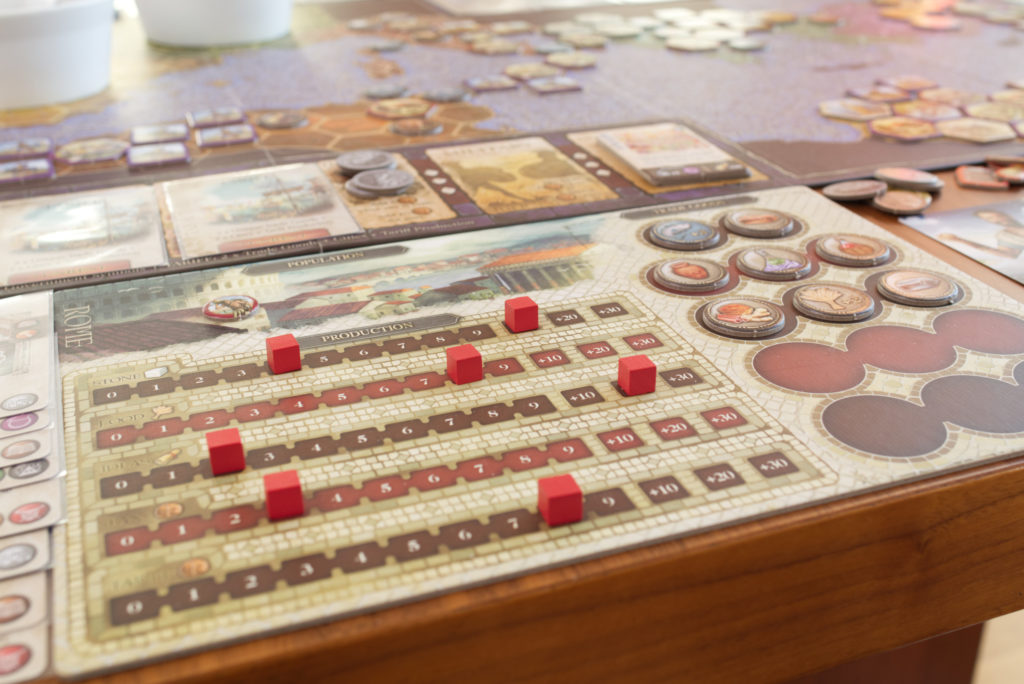
As for the minis: I prefer the substantial but compact box of the retail edition over having problems to store the Colossal Edition. Also the board is very busy already. I don’t think having miniatures will improve the readability of the board state but rather further reduce it. E.g. with cardboard tokens, military units of the same type can for example be stacked, a population marker be put on monuments to mark who owns them, etc.
Conclusion
I can kind of see why there are people on both ends of the spectrum when it comes to Mosaic. It reminded me most of how I felt while playing Terraforming Mars or Ark Nova. I enjoy the initial rush of trying to snatch up some particularly juicy technology cards or building when there is a nice bonus card in the market. On the other hand taking a production (=work) action is particularly painful because you’re basically doing nothing while your co-players pick up nice things from the various markets or good spots on the board. It’s quite surprising how few production actions one has to take if one gets into a good flow of getting resource bonuses from building cities or buying technology cards. In one particularly memorable session, my initial starting technology draft contained a large number of “get X per …” cards which I kept on my hand for a long time. I started to collect the required symbol wherever I could and then in one round triggered a cascade of technology cards which not only granted me lots of resources and population but also the symbols to achieve a Golden Age requirement which then gave me an additional bonus. It felt great.
The big problem is that this was about 2/3 through the game which seems to be symptomatic for Mosaic. For the rest of the game, I couldn’t do much more than consolidate the majorities I had and try to bring the game to its end as fast as possible. I found similar problems with the game’s arc in all my plays. While it’s fun to carefully collect your first 10-15 cards, it at some points becomes a question of “yet another”. At the end of a game, I couldn’t tell you a single technology by name that I got but go on for minutes what a table hog this game is and where I’m supposed to put 30-40 cards in a way so all symbols are visible and I can remember the 2-3 that have ongoing effect.
While there are a number of people online that suggest adjusting the deck sizes to tighten the game arc, I think that this is only part of the issue with Mosaic. Its theming and production creates certain promises and expectations on which it ultimately fails to deliver. If you purely LOOK at it’s components, you see a large map, three different types of units, even two different types of cities, tons of technologies, forms of government, wonders, achievements, population, … and the game you’ll be imagining is simply amazing. But Mosaic PLAYS as a “civilisation” game where there is no real tech tree, most techs in fact don’t even haven an ongoing effect (unless you want to call +3 idea production an ongoing effect), that beautiful map is in large parts irrelevant (because there are few spatial consequences, it’s just buckets of influence), decks that never reach their scoring card, government tiles that primarily seem to exist because one has to have government types in a civ game.
The game gives each player siege engines although there is only a single tech card (which might not even show up) that enables a single player to build them. It introduces two regular types of military unit which are for most intents and purposes exactly the same. The only reason they are distinguished is because certain technology cards give bonuses on certain types of units but you won’t know which will come up. Or take all those trade good tokens that one so laboriously has to place on the board. They only become relevant if you either build a manufacturing town (for set collecting) or plan on triggering tariffs repeatedly, both of which a lot of people will simply ignore.
It’s almost like there are two Mosaics: the game it presents itself to be by its appearance and the game it really is at its core. Case in point: the rule book is 26 pages, of which the first 8 are fluff or material overview, and pages 19-26 are an appendix of various cards that doesn’t even provide additional player help but are just there for reference. While probably well intended, it feels like an attempt to blow up the rule book so it looks substantial. Of the core rule pages themselves, large parts are filled with flavour text. Don’t get me wrong: I think it is a huge plus that Mosaic’s game mechanisms are so simple to learn. That creates a great flow while playing that keeps all player engaged. But why then have a 26 page manual? And it then doesn’t even manage to address some very obvious questions and problems at lot of players encounter (e.g. “what is that question-mark trade good token for”, “what does ‘control’ mean”, “what’s the difference between infantry and cavalry”, …). It’s a very odd mix.
So what is Mosaic? Is it a civilisation game? No. I would say it is an action-efficiency race where players primarily work on getting the right combination of tech card or build card bonuses to avoid having to spend too many turns on production. While region majority is hotly contested, the primary race is to fulfil the requirements to get civilisation achievement or Golden Age tokens before other players can do so. It’s vitally important to be able to read the board state, know when you are in competition with another player and when you still have 2-3 turns to achieve some particular goal. It’s also a game where you don’t want to buy a mediocre card because its replacement might be just what your opponent needs.
Where Mosaic shines is its flow and its snappy turns. Since pretty much everything that is put on the board stays there and no card you once get is ever discarded, there is rarely waiting time. There is also no ongoing income or battle, cutting out another factor that takes time in other games. This produces a great sense of speed, efficiency and accomplishment as you build up your own collection of tech and build cards.
Its biggest problem is that the game arc doesn’t quite end right with the last 25-30% being less fun than the part before it. There are also multiple usability issues with regards to reading the board state. The main board is so big, it’s really difficult to read the wonder/golden age/civilization achievement conditions from the other end of the board. It’s virtually impossible to keep track which of the multitude of tech cards each opponent has might be an ongoing effect that is relevant for you. And it’s difficult to judge who might be in the lead at any given point.
I’m quite sad that Mosaic isn’t for me. While it might not be the grandiose civ experience in 2 hours a lot of others have hoped for, I would have been happy to have my version of a Terraforming Mars or Ark Nova (both of which I didn’t really enjoy): a snappy efficiency race with a nice theming and great art. But there are just too many issues, game arc just being one of them. A part of me wishes there would be tracks for the nine pillars of civilisation somewhere on the main board such that I wouldn’t have to keep all those cards laying in front of me that don’t really have an effect. It also would make it easier to see with who you are in competition with. Or that the map itself wouldn’t feel so much like an afterthought. But then again Mosaic would lose much of either its visual allure or simple rules. Mosaic seems to be torn between two very different tasks: trying to appear like an epic, beautiful civilisation game and providing a quick, fun, card-based action-efficiency game. There is a lot good in both parts individually, but unfortunately they don’t quite come together …
